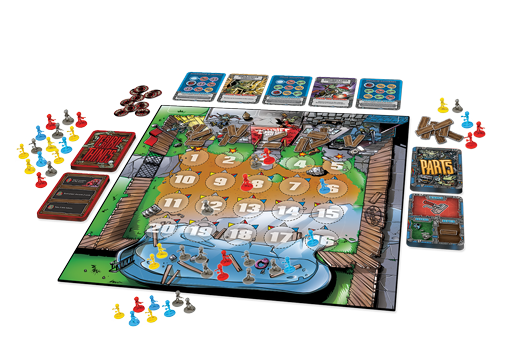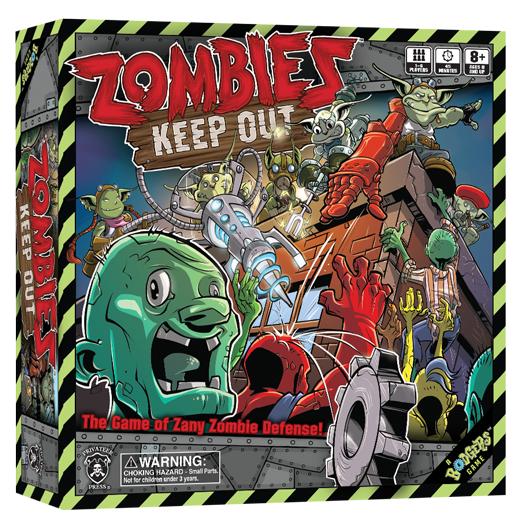

So it turns out zombies are pretty popular. There are lots of movies, TV shows, book, and comics based on everyone's favorite undead shamblers. Video games have seen a whole host of zombie themes, and the same is also true with games of the tabletop variety. In this column alone, we've covered two zombie-themed games already: Zombicide and Dead Panic. We're going to take a look at another game featuring zombies today, Zombies Keep Out, which is different enough from other similarly themed games that I believe it's worthy of consideration.
Zombies Keep Out comes from publisher Privateer Press. This company is best known for their very successful Warmachine/Hordes tabletop miniatures wargame. Privateer Press has expanded into more traditional board game territory with a line of simpler, light-hearted titles. Known as the Bodgers line, these games involve a group of colorful goblin inventors and their zany, often dangerous creations. In Zombies Keep Out, the goblins' workshop is being invaded by, you guessed it, zombies. The goal is to create enough defensive mechanisms before the undead hordes overrun the workshop.

There are four different types of zombies, differentiated by color. The zombies shamble from one end of the workshop to the other down a series of lanes, very similar to Plants Vs. Zombies. At the end of each lane are barriers protecting the door, windows, and other areas of the workshop. Each zombie color prefers one lane, and will move to it using the handy directional arrows on the map. If a blue leaper zombie ends up in the balcony lane, for example, it will bash away two wooden barricades (represented by tokens). If the central door, or three total locations, are destroyed in this way, the game is over and the goblins are presumably eaten by the undead.
Luckily, these goblins are smart enough to "bodge" together various parts into weapons that can be used to defend the workshop. Gears, levers, and pistons are represented by cards drawn from the parts deck. Blueprint cards show what designs for defensive measures are available. By collectively playing the parts cards in the order prescribed on the different blueprints, players work together to build these fantastic contraptions. Once three defenses have been assembled, the goblins have enough firepower to defeat the zombies and win the game.

This may all sound complex, but it really isn't. In fact, the game is extremely intuitive and turns flow by at a good pace. To start the turn, a player draws a Terrible Things card, and resolves it. Generally, three different detrimental options are provided, and choosing between them can be very difficult! Do you want to spawn more blue zombies, let all red ones move forward, or discard a precious parts card? Once the Terrible Thing has happened, the player can take an action: draw a parts card, play a part on a blueprint, repair a location, defend, or my personal favorite, PUSH THE BUTTON! Once a contraption is assembled, you can push the button to use it, and this means multiple zombies are getting blown up. It's a lot of fun and a nice reward for getting those inventions built.
One of my favorite mechanics in the game is the use of bite tokens. One common option on Terrible Things cards is to gain a bite token. When you have one bite token, you can't trade cards with other players, and must use slurred speech when talking. Two bites, and you can no longer build inventions, and must grumble all your words. Three bite tokens are particularly horrific; you can't use any words, only grunts. On top of that, you have to hold up one, two, or three fingers before drawing a Terrible Things card and then resolve whatever result you "picked". This can be devastating. At four bite tokens, the player becomes a zombie totally, and must constantly groan. A zombie player can take no actions, and has to draw TWO Terrible Things cards each turn. It may sound goofy, but in practice, it is quite hilarious and adds lots of flavor to the game.
The cooperative elements in Zombies Keep Out are mainly confined to the tinkering action. The blueprints show parts that have to be assembled in order; you might need a gear, then a lever, then two pistons, for example. Players can trade one card to another player each turn, so long as they don't have a bite token. Figuring out who needs to trade what card to whom and in what order is very important, and it gives a nice sense of teamwork when you manage to assemble a Crab Grabble or Zombiphage Cannon. Another minor element of cooperation is choosing the Terrible Thing each turn. Often, a player can take a bite token or discard a card in order to prevent something worse happening to the other players. The game doesn't ooze with a co-op feel like Flash Point Fire Rescue or Legendary Encounters, but it's not multiplayer solitaire, either.
There's a lot to like about Zombies Keep Out. The game is simple enough to explain easily, and you will be playing in minutes. There are enough deep decisions to be made to maintain interest, and there is a nice progression of tension as the zombies pile up. The theme is fun, with colorful goblins and the giggle-inducing bite token mechanic making the experience memorable. Best of all, the game is fairly inexpensive, something that is becoming uncommon for co-op board games. If you aren't sick to death (undeath?) of the zombie genre yet, Zombies Keep Out is worth a look.